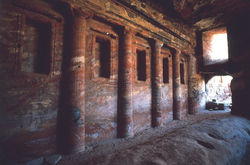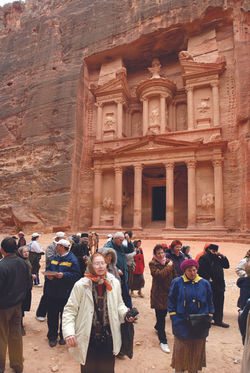The Nabateans City of Petra
You are here: Home > Attractions > The Nabateans City of Petra
The giant red mountains and vast mausoleums of a departed race have nothing in common with modern civilization and ask nothing of it except to be appreciated at their true value - as one of the greatest wonders ever wrought by Nature and Man.
Although much has been written about Petra, nothing really prepares you for this amazing place. It has to be seen to be believed.
Petra, the world wonder, is without a doubt Jordan’s most valuable treasure and greatest tourist attraction. It is a vast, unique city, carved into the sheer rock face by the Nabataeans, an industrious Arab people who settled here more than 2000 years ago, turning it into an important junction for the silk, spice and other trade routes that linked China, India and southern Arabia with Egypt, Syria, Greece and Rome.
Entrance to the city is through the Siq, a narrow gorge, over 1 km in length, which is flanked on either side by soaring, 80m high cliffs. Just walking through the Siq is an experience in itself. The colors and formations of the rocks are dazzling. As you reach the end of the Siq you will catch your first glimpse of Al-Khazneh (Treasury).
This is an awe-inspiring experience. A massive facade, 30 m wide and 43 m high, carved out of the sheer, dusky pink rock-face and dwarfing everything around it. It was carved in the early 1st century as the tomb of an important Nabataeans king and represents the engineering genius of these ancient people.
The Treasury is merely the first of the many wonders that make up Petra. You will need at least four or five days to really explore everything here. As you enter the Petra valley you will be overwhelmed by the natural beauty of this place and its outstanding architectural achievements. There are hundreds of elaborate rock-cut tombs with intricate carvings - unlike the houses, which were destroyed mostly by earthquakes, the tombs were carved to last throughout the afterlife and 500 have survived, empty but bewitching as you file past their dark openings. Here also is a massive Nabataeans-built,
Roman-style Theater which could seat 3,000 people. There are obelisks, temples, sacrificial altars and colonnaded streets, and high above, overlooking the valley, is the impressive Ad-Deir Monastery – a flight of 800 rock-cut steps takes you there.
Within the site there are also two excellent museums; the Petra Archaeological Museum and the Petra Nabataeans Museum both of which represent finds from excavations in the Petra region and an insight into Petra's colorful past.
A 13th-century shrine, built by the Mameluk Sultan, Al Nasir Mohammad, to commemorate the death of Aaron, the brother of Moses, can be seen on top of Mount Aaron in the Sharah range.
Inside the site, several artisans from the town of Wadi Musa and a nearby Bedouin settlement have set up small stalls selling local handicrafts, such as pottery and Bedouin jeweler, and bottles of striated mufti colored sands from the area.
Another important site near Petra is Al Beidha or Little Petra, which is one of the must-visit sites for the casual visitor in Wadi Musa. This site is only a few kilometers from Petra. It is literally hidden away in the center of a mountain.
The entrance to Little Petra contains a small Siq through which visitors must pass.
You will discover this miniature version of Petra which contains a number of notable tombs. You will note how well preserved some of these monuments are.
Farther inside is a magnificent monument high on the side of the cliff.
In the street of dining halls, you will discover a small dining hall or meeting hall nearer the front entrance to Al Beidha. Most of the facades have been washed away by floods but the halls still remain.
The smaller sinks were usually obtained running water from larger water cisterns located farther up the mountains, as well as one or two large ones located next to the dining hall.
All through Little Petra there are, stairs leading up to exposure platforms and high places.
At the rear of Little Petra is a set of stairs leading up to the sky above. If you have time, climb the stairway at the back of Al Beidha and explore the small boxed canyon in the rear. It is one of the most hidden and secluded places around Petra and would have made a great hideaway.
 |  |  |
|---|---|---|
 |  |  |
 |  |  |
 |  |  |
 |  |  |
 |  |  |
 |  |  |
 |  |  |
 |  |  |
 |


